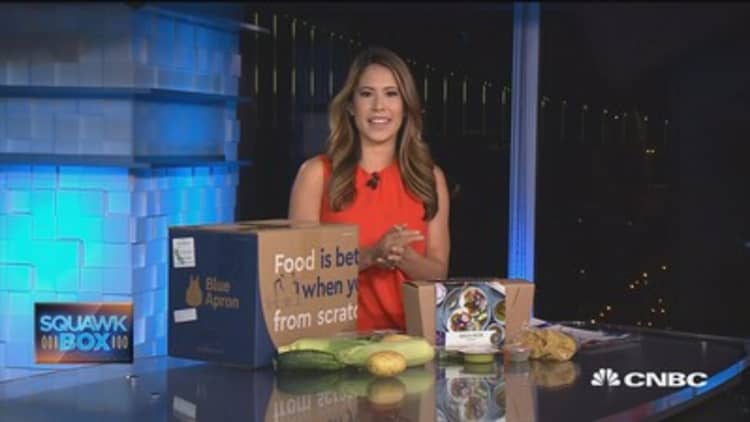Blue Apron has given millions of people the chance to cook with fresh ingredients without stepping foot in a store. Now grocers are fighting back.
Whole Foods is experimenting at some stores with displays that feature a recipe and all the raw ingredients a shopper needs to prepare it. Kroger is going further with its own test of kits with premeasured ingredients at four of its Cincinnati stores.
Both offerings are only available in stores, so they do not directly compete with Blue Apron's online business, which ships to a customer's home. But competition for meal kit companies is fierce, even without putting grocery stores in the mix.
Meal kit sales account for only $1.5 billion of the $800 billion grocery business, according to Mikey Vu, a partner at Bain & Company. But new companies are popping up, hoping to capture a piece of what could be a quickly growing business.
"Grocery stores see this as a threat, and they're going to find ways to fight back," Vu said. "It could be with in-store solutions and their own meal kits or partnering to sell meal kits."
There's no doubt, shoppers are looking for convenience and low prices. If grocery stores can master offering both in its meal kits, they could further pressure Blue Apron and the budding industry.
Grocery stores can sell cheaper options than most meal kit companies can because they don't have to pay for packaging and delivering products, said Rob Wilson, managing director and partner at L.E.K Consulting. Online companies do, and that has stunted their ability to make money.
The average meal made from a kit costs $10 per person, according to the NPD Group. That's quite a bit more than the $4 cost of an average meal made from ingredients purchased at a grocery store.
"The number one reason consumers leave the meal kit industry is price," Wilson said. "Convenience and packaging and other things are up there, but it's price, and that's the last thing you want to hear in an industry that's struggling to make money."
Whole Foods' new display does not require any packaging. The stores simply display a recipe and a picture of the finished product. Underneath, they stock all the ingredients, both fresh and packaged, needed to make it.
"We're always testing new and innovative meal solutions for customers, and we're always looking to local flavors and local customer interests," a Whole Foods spokesperson said.
The ingredients are not portioned, so customers must buy an entire bottle of olive oil or a whole bag of rice. The concept may not be ideal for shoppers, but it is attractive for grocers, Vu said.
They need organize the setup, but they don't need to pay to assemble kits. The convenience of buying all the ingredients in one spot may entice customers. The possibility of wasting food may not.
"If I'm making a meal for one or two people, am I worried I'll waste some of the food if I don't get around to using it?" Vu asked. "It's a low cost, low complexity way to simulate meal kits, but I think (Whole Foods has) to try and do more than that. I think they have to push into meal kit space as well."

Whole Foods also has partnered with Salted to sell the company's meal kits in Whole Foods stores around Los Angeles. Salted sells boxes that can last on a shelf for two weeks and that contain almost everything needed to make a meal, except meat, lettuce, salt, pepper, oil and coconut milk, according to a review of recipes on the company's website.
Kroger has adopted the traditional meal kit concept with portioned products. It launched a pilot program in May with five seasonal recipes. Each box feeds two people and costs $14 to $18, or $7 to $9 per person. Blue Apron's two-person plan costs $9.99 per serving.
Kroger boasts that although customers can't have their meals delivered to their homes, they can buy the boxes as they please instead of committing to a subscription. A Kroger spokesperson said customers have responded favorably.
Blue Apron subscribers pay $59.94 to receive three meals per week for two people, according to Blue Apron's website. Customers receive boxes that contain portioned ingredients to cook a designated recipe. The company said it has the ability to deliver to over 99 percent of the U.S. population.
Blue Apron says its the combination of the services it provides that makes its product a good value for consumers. This includes the planning of the meals, creating the recipes and providing specialty ingredients.
"Blue Apron has reimagined the traditional grocery business model and developed an integrated ecosystem that employs technology and expertise across many disciplines," the company said in a statement.
But as more grocers follow the trend, they could steal customers from fledgling meal kit companies, Wilson said. Or they could spark new interest in the category. Either way, he said he expects to see a "shakeout" of digital companies in the industry.
"The main problem is the meal kit industry capitalizes upon a number of unmet consumer needs for convenience and trying new recipes and doing that at home, so the industry won't go away," he said. "But I foresee a shakeout because most of the companies in the industry don't make any money, and most lose money. That can only continue for so long."
The one company that is in the industry that does not care about money is Amazon, Wilson said. Last month, Amazon started selling its new meal kits to Prime members in select locations. That, he said, will only accelerate the rate of companies crashing under the pressure.
It's no wonder Wall Street's skepticism about Blue Apron is growing. The company's stock price has fallen to $5.85 from $10 when it went public in June. Investors will learn more Thursday about how it's faring when the company posts its first quarterly earnings report.


